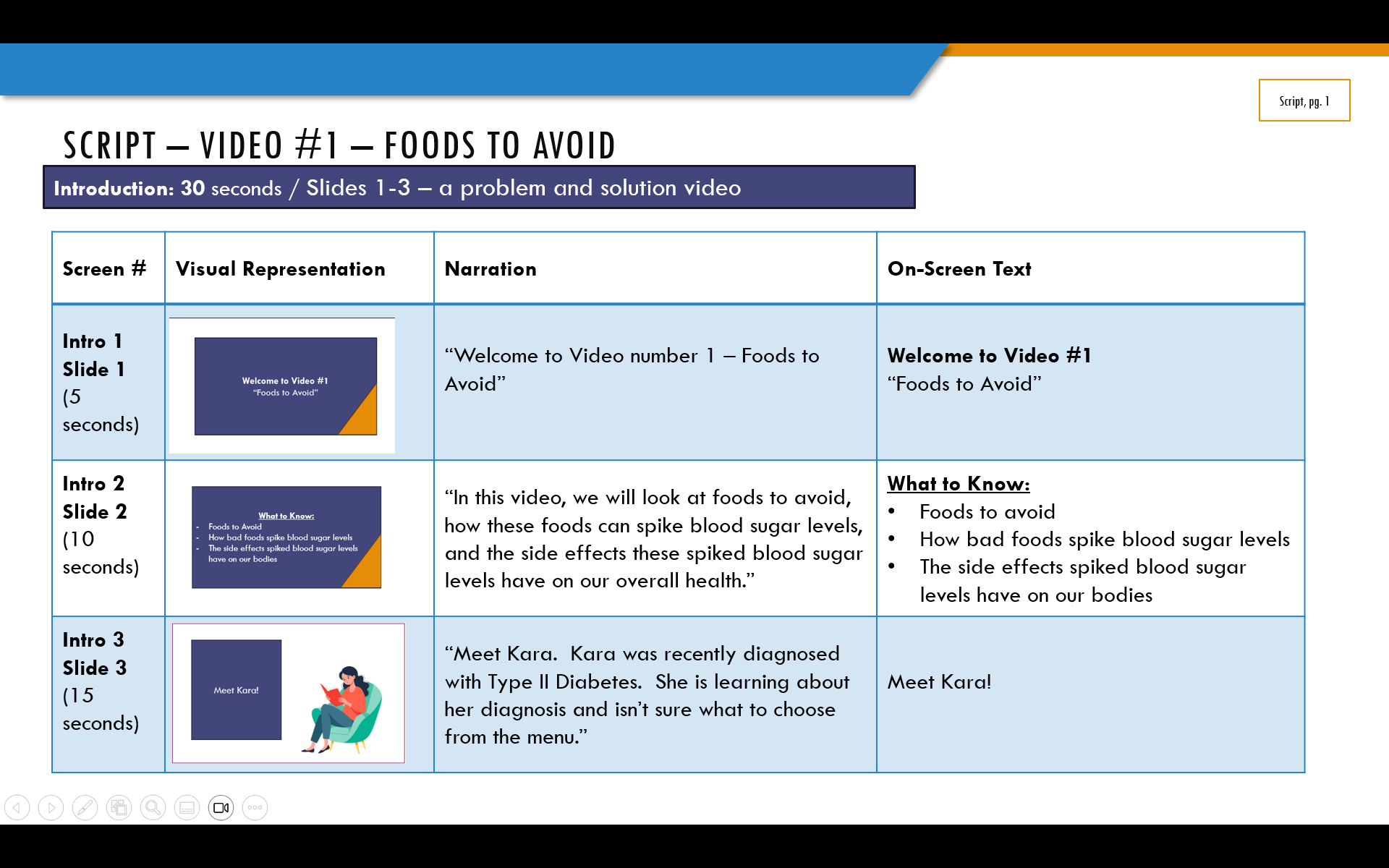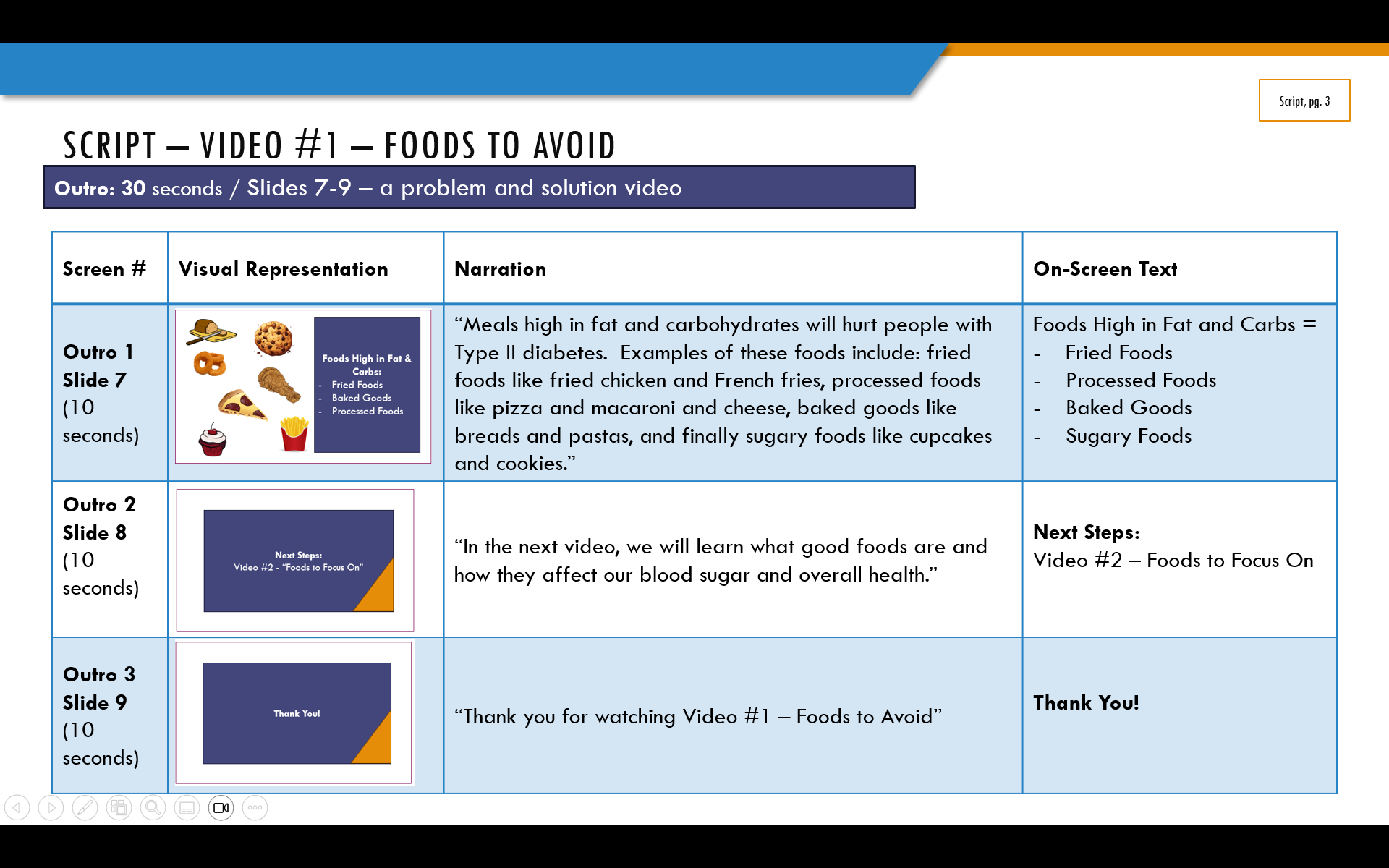
Certification Project
Type II Diabetes - The Basics
It all began with a problem. How do you provide information and care to people who cannot travel to the doctor and receive it? This is the problem I was hoping to solve.

Overview
In 2024, I earned a Professional Certificate in Digital Learning and Instructional Design from the Digital Learning Institute, graduating with distinction. As part of the certification requirements, I completed a portfolio project showcasing my instructional design expertise. Below is an overview of the project I developed during the certification process.
Project Summary:
This video-based learning series was designed for The Hearts and Hands Clinic, a non-profit organization in Statesboro, Georgia, dedicated to providing basic healthcare services to uninsured and underserved community members. Many of the clinic's patients suffer from Type II Diabetes and face challenges related to travel and financial constraints. To address these barriers, I developed a learning plan to educate patients about their diagnosis, how to test and interpret blood sugar levels, and practical guidance on nutrition and exercise.
-
How can you provide basic care to patients who are unable to come into the clinic? The needs include a basic knowledge and understanding of Type II Diabetes as well as how to check blood sugar levels and what those levels indicate. Finally, lifestyle changes in nutrition and exercise.
-
Create a video-based educational series to assist patients with information on their diagnosis, instructions for basic care, and lifestyle changes. Offer incentives for those who participate in the video learning.
-
Patients of The Hearts and Hands Clinic with Type II Diabetes. These patients are typically older individuals, lower-income with limited access to technology and resources.
-
Content research, action mapping, storyboarding, scripting, visual design, video prototype creation
-
Notion, Powtoon, Perplexity.ai, Microsoft PowerPoint, Microsoft Word, ChatGPT, & Stock Images
My Process
The first step in developing this course was identifying the unique challenges faced by patients at The Hearts and Hands Clinic, particularly those with limited access to technology or difficulty attending in-person appointments. My goal was to create content that was accessible, engaging, and easy to understand for a diverse group of patients—ranging from those with limited internet access to those unfamiliar with advanced medical concepts.
To ensure the material was digestible, I structured the course into clear, bite-sized segments. The content was organized into a series of short, focused videos covering the key aspects of diabetes management: understanding the diagnosis, testing and interpreting blood sugar levels, and adopting lifestyle changes for nutrition and exercise.
Recognizing the varying levels of technological proficiency within the target audience, I took steps to ensure the videos were compatible with low-bandwidth environments and could be accessed on a variety of devices, including smartphones. I also incorporated subtitles and voiceover narration to accommodate patients with hearing impairments or those who preferred audio content.
The tone of the videos was intentionally conversational and approachable. To make the content relatable, I used visual aids and real-life scenarios that connected the information to the patients' daily experiences. For instance, instead of just listing harmful foods, I demonstrated the symptoms that arise when unhealthy food is consumed, providing a more tangible understanding of the consequences.
Given that patients could not attend in-person visits, I designed the course for self-paced learning, allowing patients to review the content as often as needed. This flexibility helped reinforce the information and supported patients in learning at their own pace.
The overall goal was to empower patients to manage their health with confidence and independence. By transforming complex medical content into accessible, patient-friendly video lessons, I created an effective learning experience that provided patients with the tools they needed to manage their Type II Diabetes—despite their technological and logistical limitations.
Content Map
In collaboration with the Subject Matter Expert (SME), we developed clear learning objectives based on Bloom’s Taxonomy to guide patients from limited knowledge of their diagnosis to a deeper understanding and practical application of diabetes management. With these objectives in mind, I created a content map that employed a top-down approach, outlining key lessons for each module category. They are as follows:
Explain the Type II Diabetes diagnosis and how having Type II Diabetes affects the body.
Describe the steps and process of checking blood sugar levels.
Interpret blood sugar level readings to determine next steps.
Recognize how food affects your blood sugar and determine how to create simple and budget-friendly meals that manage your diabetes.
Examine the benefits of exercise and how to implement small movement changes into everyday life.
The content map breaks down the five main topics into bite-sized microlearning videos, allowing patients to engage with the material at their own pace and convenience. This modular structure ensures that the course is accessible, enabling learners to understand and apply complex medical concepts in manageable chunks.
Each video lesson, approximately five minutes in length, addresses common questions and concerns patients have about their diagnosis. The linear flow of the video series creates a cohesive learning experience, where patients can return to the material as needed, reinforcing their understanding over time.
By breaking down challenging content into short, focused videos, this microlearning approach makes complex topics more digestible and easier for patients to apply in their daily lives.
Storyboard & Script
During the analysis phase, we identified that our target learners were older, lower-income individuals with limited access to technology. While many had access to cell phones and tablets, laptops were often out of reach. This insight, along with the learning personas, guided our decision to use simple, accessible language and animated videos to deliver the content in short, engaging mini-lessons.
Given the budget constraints of the non-profit clinic, animated instructional videos were an ideal solution, enabling us to effectively convey important concepts without incurring high production costs. I chose a scenario-based approach for the video storyboard, featuring a character named Kara, who has recently been diagnosed with Type 2 Diabetes.
Using a scenario helps demystify complex information, such as how high-fat, high-carbohydrate foods are processed differently in individuals with this condition. The story format allows us to present this information in a relatable, understandable way, avoiding difficult medical jargon while still delivering key content.
Below is the visual script for Module 4, Lesson 1 – “How Does Food Affect Me?”
Prototype Development
For the prototype, I used Powtoon, a video creation tool ideal for producing animated content. This program allowed me to enhance my skills while creating a user-friendly, visually engaging instructional video for Module 4, Lesson 1. Powtoon proved to be both cost-effective and easy to use, making it an excellent choice for the project’s budget and scope.
While I adhered to the original storyboard and script, the development process revealed areas where adjustments were necessary. I made updates to the storyboard and script to reflect these changes, ensuring the final product was aligned with the learning objectives and effective for the target audience.
Reflection & Takeaways
This project was a valuable opportunity to step outside of my comfort zone while working on a topic I am passionate about—health and wellness. Collaborating with the Subject Matter Expert provided real-world experience with Type 2 Diabetes content, and the learner personas helped me tailor the delivery to meet the needs of the patients.
Through this process, I was able to build confidence in applying the ADDIE model, incorporating eLearning principles such as Mayer’s Principles of Multimedia Learning, and refining my use of learning theories like Gagné’s Nine Events of Instruction.
While project funding and time constraints prevented the full completion of the course, the experience was incredibly rewarding. I gained invaluable insights into The Hearts & Hands Clinic, their patients, and Type 2 Diabetes, which has motivated me to continue developing this project in the future. I am hopeful that, despite the current pause, the initiative will resume and reach its full potential.



